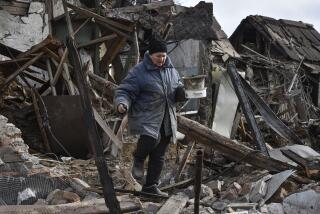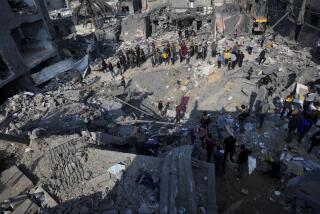NEW ANALYSIS : Aim Is to Cripple Rebels if Future Strikes Needed
- Share via
WASHINGTON — The allied bombing campaign launched against the Bosnian Serbs is part of a broad plan designed to cripple the rebels’ fighting arsenal and leave them vulnerable to further attacks if NATO decides they are necessary.
The waves of allied planes that took off early Wednesday set their sights on the rebel Serbs’ air-defense systems, radar sites and communications centers in order to blunt their ability to shoot down North Atlantic Treaty Organization warplanes and lay bare their artillery, tanks and other heavy weapons to subsequent attacks.
The next stages of the campaign--plotted to continue for several more days if necessary--have focused on destroying a broad array of strategic targets, from command centers and ammunition dumps to tanks and howitzers, which the nationalist Serbs have used to maintain their edge over Bosnian government troops.
The operation also is designed to deliver another message to the rebel Serbs: that despite NATO’s seeming paralysis during most of the long Bosnian war, the allies now are united enough to mount a serious threat and have the capability to inflict serious damage.
“The pinprick strikes that the allies had launched previously had given the Serbs the impression that NATO’s threats weren’t believable,” said Robert W. Gaskin, a former Pentagon planner who is familiar with the allied strategy. “This is intended partly to dissuade them from that view.”
The NATO and U.N. attack force included dozens of aircraft--from air bases in eastern Italy and from the U.S. aircraft carrier Theodore Roosevelt--along with artillery units from a new British-French rapid-reaction force set up to protect U.N. peacekeepers in the region.
Along with the usual Air Force F-15E and F-16C fighters, the air armada has included Navy and Marine Corps F/A-18 attack aircraft, British Tornado fighters, French Mirage F-1s and 2000s and Dutch F-16s. The Americans also deployed AC-130H gunships.
The allies deployed extra radar-jamming aircraft to help protect the NATO fighters from Bosnian Serb antiaircraft missiles. The escorts include Air Force EF-111s and Navy EA-6Bs, many of them capable of destroying any of the missile batteries that they find.
And many of the American warplanes used in the campaign are equipped with laser-guided missiles capable of hitting the smallest targets with extraordinary precision, even at night. Most aircraft from other NATO countries do not have that capability.
One key to the allies’ success so far has been their wide array of sophisticated intelligence-gathering equipment, from satellites and U-2 spy planes to reconnaissance aircraft, drones and ground sensors--enabling them to photograph targets, home in on radar and intercept radio traffic.
As a result, the allies had enough up-to-date information about Bosnian Serb military sites and their coordinates to be able to put together a list of targets almost as soon as the United Nations decided to authorize the raids.
They also were able to take intelligence “snapshots” after every raid to tell pilots precisely which targets have been destroyed and which are still standing--a technique that reduces unnecessary duplication and helps alert pilots to which Serbian weapons still pose a danger.
The sorties were launched a day and a half after a shelling attack on central Sarajevo, the Bosnian capital--an assault blamed on the Bosnian Serbs--killed at least 37 people and injured 80. The allies’ relatively quick response was made possible by months of detailed planning and painstaking cataloguing of potential targets while NATO has been enforcing the “no-fly” zone over Bosnia-Herzegovina.
“The surveillance that’s been going on has really been extraordinary,” retired U.S. Marine Corps Lt. Gen. Bernard E. Trainor, now a military analyst at Harvard University’s Kennedy School of Government in Cambridge, Mass., said in an interview Wednesday. “They [the allies] have had a pretty good picture of what the Serbs had. All they had to do is put together the right kind of package. And given our experience, even that was almost routine.”
Enforcing the “no-fly” zone also enabled NATO pilots to become familiar with Bosnia’s harsh terrain and weather.
Ironically, at least some of the techniques being used during this week’s attacks were enhanced as a result of the downing in June of the U.S. F-16 piloted by Air Force Capt. Scott F. O’Grady, who was rescued by a Marine unit.
A high-level investigation found that the Air Force pilot might have avoided being shot down if he had been warned of Serbian missiles in time. Accordingly, U.S. officials moved to speed the transmission of fresh intelligence to pilots who were about to fly over Bosnia.
Authorities also ordered special radar-jamming planes to accompany all fighters flying over Bosnia. While fighters such as O’Grady’s have some ability to pinpoint and destroy enemy missile sites, they are not as effective as the EF-111s or the EA-6Bs.
As a result, when the allies began their attacks Wednesday, they were able to launch more than 60 aircraft on double and triple sorties without suffering any casualties for 12 hours, when a French Mirage 2000 fighter was downed.
* POWERBROKER: Bosnian Serbs cede key vote on peace to Serbian president. A6
* RELATED STORIES: A12-13
More to Read
Sign up for Essential California
The most important California stories and recommendations in your inbox every morning.
You may occasionally receive promotional content from the Los Angeles Times.










